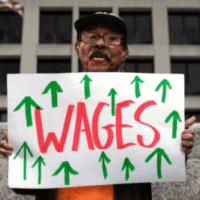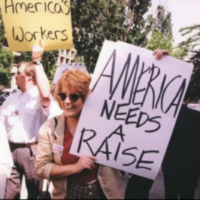State legislatures around the country are attempting to bar cities and counties from passing their own minimum wage laws through “preemption” laws that take away a locality’s power to enact such measures. Local minimum wage laws play a key role in ensuring that a worker can afford the basics in cities or counties where the cost of living is higher than in other parts of the state. While proponents of preemption often claim that their main concern is to avoid a “patchwork” of wage levels within a state, in reality, these bills are motivated by a desire to block higher wages. Ultimately, preemption of local minimum wage laws is a priority for big business. Advocates, workers, and legislators who support an economy that works for all should oppose the preemption of local minimum wage laws.
Many States Authorize Cities & Counties to Enact Local Minimum Wage Laws; Over 40 Cities & Counties Have Successfully Enacted Such Laws
- Many states, cities, and counties have the power to adopt local minimum wage laws that provide for a higher minimum wage than state or federal law.
- The power to enact a local minimum wage allows high-cost-of-living communities to adopt a minimum wage that better meets local living costs.
- The power to adopt higher local wages also ensures that localities can address the need for higher worker pay when the state is unwilling to raise the minimum wage.
- Across the country, more than 40 cities or counties in states such as California, New Mexico, and Arizona have adopted local minimum wage laws that have successfully helped workers better afford the basics.[i] Most recently, Minneapolis[ii] adopted its own local $15 minimum wage.
- Local minimum wage laws—which generally impact just a few high-cost communities in a particular state—have proven effective and manageable for businesses.
- The White House Council of Economic Advisors released a new study in December 2016 of all U.S. minimum wage increases since the recession. Like the lion’s share of recent rigorous research on the minimum wage, it found that these increases delivered significant raises with little negative effect on job growth.[iii]
- In April 2015, Seattle began implementation of its new wage floor, which will reach $15 by 2021. In a front-page story titled, “Apocalypse Not: $15 and the Cuts that Never Came,” the Puget Sound Business Journal reported on “[t]he minimum wage meltdown that never happened,” explaining that Seattle’s restaurant industry has continued to expand and thrive as the $15 wage phases in.[iv] As of October 2016, the number of food services and beverage industry business licenses issued in Seattle had increased by 9 percent since the minimum wage law went into effect.[v]
- A 2014 study examining the impact of San Francisco’s minimum wage ordinance and other city compensation requirements that cumulatively raised employment costs 80 percent above the federal minimum wage rate found no adverse effect on employment levels or hours. It found, in fact, that food service jobs—the sector most heavily affected—grew about 17 percent faster in San Francisco than in surrounding counties during that period.[vi]
Local Power to Raise the Minimum Wage Is Important for High-Cost-of-Living Communities; Provides Means to Raise Wages When Political Gridlock Prevents Statewide Action
- Local power to raise the minimum wage allows higher-cost-of-living communities in a state to adopt wages that better match their higher housing and living costs. A U.S. Bureau of Labor Statistics analysis found that urban households in 2011 spent 18 percent more than rural households, and higher housing costs by urban consumers “accounted for about two-thirds of the difference in overall spending between urban and rural households.”[vii]
- Another key role it plays is providing a means of raising wages when political gridlock prevents the state from acting—for example, when a governor blocks action to raise wages, or when one or both houses of the legislature refuse to act.
- Across the country, many states that have raised the minimum wage, such as New Mexico, Illinois, and Minnesota,[viii] now have legislative majorities or governors who are blocking any action to raise the state minimum wage.[ix] Local minimum wages in those states provide a crucial alternative means of raising pay.
- Progressive legislatures that raise the statewide minimum wage are sometimes urged to ban local minimum wages in the process, with opponents arguing that they are unnecessary. Or, sometimes, opponents offer to allow a one-time statewide raise if minimum wage supporters agree to ban local minimum wages in the future.
- Progressives should reject such short-sighted deals that handcuff localities from supplementing state laws in the future. For example, in 2004, Democratic Wisconsin Governor Jim Doyle agreed to ban local minimum wages as part of a deal to get the Republican-controlled legislature to raise the state’s minimum wage. Wisconsin leaders now realize that it was a bad deal, and it is preventing cities and counties from addressing the minimum wage, since Governor Scott Walker is blocking any statewide increase.[x]
Responding to Pressure From Big Business, More State Legislatures Are Attempting to Prohibit Cities From Enacting Wage Laws
- As of July 6, 2017, 25 states have passed laws that preempt cities from passing their own local minimum wage laws.[xi] See Figure for a map of states that have passed minimum wage preemption laws.
- Most state preemption laws have been passed in recent years as a response to successful local campaigns to raise the minimum wage.[xii] In 2016, for example, the State of Alabama passed a preemption bill after the City of Birmingham passed a local minimum wage law.[xiii] The effect was not only to block future local minimum wages, but to invalidate Birmingham’s higher minimum wage law.
- While proponents of preemption claim they are concerned about having a “patchwork” of wage levels across the state, businesses are accustomed to dealing with varying rules across cities and counties. Cities in most of the country have extensive “home rule” powers allowing them to legislate over a wide range of areas in order to adequately respond to local needs. Businesses have adapted to varying rules concerning traffic, business licenses, construction, zoning, and many other local laws. Local minimum wages are no different.
- Most minimum wage preemption laws have been pushed and adopted by largely conservative state legislatures in recent years[xiv] in response to pressure from big business, which generally opposes minimum wage increases. In other words, the real motivation behind recent state preemption bills is not uniformity, but rather a desire to limit the ability of local elected officials to raise pay.
- Taking away local control over wages has become a major priority of the American Legislative Exchange Council (ALEC), a corporate-backed group with extensive lobbying resources and influence in our state legislatures.
- As a Slate article explained, “[f]ounded in 1973, [ALEC] has paired lawmakers with businesses and special interests ranging from Google to the AARP to Exxon Mobil” to produce “hundreds of ‘model policies’ that have made their way into state codes.”[xv] ALEC has successfully preempted local laws on a growing list of important issues like guns, tobacco, wages, the banning of plastic bags, fracking, and pesticides.[xvi]
- ALEC has drafted “model” preemption bills to prohibit local minimum wage laws since at least 2002.[xvii] Preempting local minimum wages was a priority agenda item for ALEC in 2016,[xviii] and the rapidly growing list of states introducing preemption bills in 2017 indicates that minimum wage preemption continues to be a top priority for big business.[xix]
Economic Evidence Shows That Cities or Counties That Adopt a Higher Local Minimum Wage Do Not Become “Less Competitive” With Surrounding Areas
- The economic evidence also shows that a city or county that adopts a higher local minimum wage does not become “less competitive” with surrounding areas, another frequent claim by proponents of preemption.
- One of the most sophisticated studies of minimum wages was published by economists at the Universities of California, Massachusetts, and North Carolina.[xx] The study looked at the impact of minimum wage rates in more than 250 pairs of neighboring counties in the United States that had different minimum wage rates.[xxi] Comparing neighboring counties on either side of a state line is an especially effective way of isolating the true impact of minimum wage differences, because neighboring counties tend to have similar economic conditions. The study found no difference in job growth rates.[xxii]
- Two of the counties compared in the study of 250 counties noted above were Washington State’s Spokane County and Idaho’s Kootenai County, where the minimum wage was substantially lower. The economists found no evidence that higher minimum wages in Washington State harmed the state’s competitiveness.[xxiii]
- A 2006 study compared job growth in Santa Fe with that in Albuquerque, New Mexico. Santa Fe was one of the first cities to enact a higher minimum wage, and Albuquerque did not have its own local minimum wage at the time of the study. The study found that Santa Fe’s higher minimum wage had no discernible impact on employment and that Santa Fe actually did better than Albuquerque in terms of employment changes.[xxiv]
Conclusion
Advocates, workers, and state legislators must reject efforts to take away local control over wages. With 42 percent of workers in the United States earning less than $15 per hour[xxv] and workers in high-cost cities and counties facing especially difficult economic challenges due to a higher cost of living, localities must be able to respond to the unique needs of workers who cannot survive on the federal or state minimum wage.
[i] National Employment Law Project, Fight for $15: Four Years, $62 Billion (Dec. 2016), https://www.nelp.org/wp-content/uploads/Fight-for-15-Four-Years-62-Billion-in-Raises.pdf.
[ii] National Employment Law Project, Minneapolis Becomes First City in the Midwest to Enact a $15 Minimum Wage (June 2017), https://www.nelp.org/blog/minneapolis-becomes-first-city-in-the-midwest-to-enact-a-15-minimum-wage/.
[iii] Sandra Black et al., White House Council of Economic Advisors, Minimum wage increases by US states fuelled earnings growth in low-wage jobs (Dec. 2016), http://voxeu.org/article/minimum-wage-increases-and-earnings-low-wage-jobs; National Employment Law Project, Minimum Wage Basics: Employment and Business Effects of Minimum Wage Increases (Oct. 2015), https://www.nelp.org/publication/minimum-wage-basics-employment-and-business-effects-of-minimum-wage-increases/.
[iv] Jeanine Stewart, “Apocalypse Not: $15 and the cuts that never came,” Puget Sound Business Journal, Oct. 23, 2015, http://www.bizjournals.com/seattle/print-edition/2015/10/23/apocolypse-not-15-and-the-cuts-that-never-came.html.
[v] National Employment Law Project and ROC-United, The Case for Phasing Out Maine’s Subminimum Wage for Tipped Workers (Oct. 2016) at 16, https://www.nelp.org/wp-content/uploads/Maine-Sub-Minimum-Wage-Report.pdf.
[vi] Michael Reich et al., Univ. of Calif. Press, When Mandates Work: Raising Labor Standards at the Local Level (2014), http://irle.berkeley.edu/when-mandates-work/.
[vii] William Hawk, U.S. Bureau of Labor Statistics, Beyond the Numbers, Expenditures of urban and rural households in 2011 (Feb. 2013), https://www.bls.gov/opub/btn/volume-2/pdf/expenditures-of-urban-and-rural-households-in-2011.pdf.
[viii] Raise the Minimum Wage, Campaigns, https://raisetheminimumwage.com/.
[ix] For a breakdown of which party controls each state legislature and governor’s office, see K.K. Rebecca Lai et al., “In a Further Blow to Democrats, Republicans Increase Their Hold on State Governments,” The New York Times, Nov. 11, 2016, https://www.nytimes.com/interactive/2016/11/11/us/elections/state-legislature-change-in-control.html.
[x] Alan Talaga, “Madland: A bad compromise by Jim Doyle hurts Wisconsin’s minimum wage fight today,” Isthmus, Sept. 6, 2014, http://www.isthmus.com/madland/article.php?article=43537.
[xi] National Employment Law Project analysis of state laws. The Florida legislature enacted statewide legislation to preempt local minimum wage laws, but the validity of that laws is currently being challenged in court based on the language of a constitutional amendment approved by voters. Florida Retail Federation, Inc. et al v. City of Miami Beach (Circuit Court of the 11th Judicial Circuit, Miami-Dade County, Florida) (16-031886-CA-10).
[xii] Of the 25 states identified in Figure 1 as having passed a minimum wage preemption law, more than half (14) adopted their minimum wage preemption law in or after 2013. See Ala. Code § 25-7-41; Idaho Code Ann. § 44-1502; Kan. Stat. Ann. § 12-16, 131; Kan. Stat. Ann. § 12-16, 130; HB3, 2016 Reg. Sess. (KY. 2017); Mich. Comp. Laws Ann. § 123.1395; Miss. Code Ann. § 17-1-51; Mo. Ann. Stat. § 285.055; N.C. Gen. Stat. Ann. § 95-25.1; SB331, 131st Gen. Assem. (OH. 2016); Okla. Stat. Ann. Tit. 40, § 160; R.I. Gen. Laws Ann. § 28-12-25; Tenn. Code Ann. § 50-2-112; HF295, 87th Gen. Assem. (IA. 2017); SB668, 91st Gen. Assem. (AR. 2017). All 25 states enacted their minimum wage preemption laws in or after 1999. National Employment Law Project analysis of state laws.
[xiii] Mike Cason, “Gov. Robert Bentley signs bill to block city minimum wages, voiding Birmingham ordinance,” AL.com, Feb. 25, 2016, http://www.al.com/news/index.ssf/2016/02/bill_to_block_city_minimum_wag_2.html.
[xiv] See supra note 14; see also supra note 10.
[xv]Henry Grabar, “The Shackling of the American City,” Slate, Sept. 9, 2016, http://www.slate.com/articles/business/metropolis/2016/09/how_alec_acce_and_pre_emptions_laws_are_gutting_the_powers_of_american_cities.html.
[xvi] Id.; Brendan Fischer, The Center for Media and Democracy’s PRWatch, Corporate Interests Take Aim at Local Democracy (Feb. 3, 2016), http://www.prwatch.org/news/2016/02/13029/2016-ALEC-local-control.
[xvii] American Legislative Exchange Council, Living Wage Mandate Preemption Act, https://www.alec.org/model-policy/living-wage-mandate-preemption-act/ (last viewed Feb. 2, 2017).
[xviii] Lisa Graves, The Center for Media and Democracy’s PRWatch, ALEC’s 2016 Agenda Moving in the States: A Snapshot (May 5, 2016), http://www.prwatch.org/news/2016/05/13099/alec’s-2016-agenda-snapshot.
[xix] Minimum wage preemption bills have been introduced in at least Minnesota (HF180), Maryland (HB317), and Illinois (SB2). State leaders have also indicated that they will seek to preempt local minimum wage laws in Iowa. See James Q. Lynch, “Iowa Legislature likely to have minimum wage debate – or two,” The Gazette, Jan. 2, 2017, http://www.thegazette.com/subject/news/government/iowa-legislature-likely-to-have-minimum-wage-debate-x2014-or-two-20170102.
[xx] Arindrajit Dube et al., The Review of Economics and Statistics, Minimum Wage Effects Across State Borders: Estimates Using Contiguous Counties (Nov. 2010) at 92(4): 945–964.
[xxi] Id.
[xxii] Id.
[xxiii] Id.
[xxiv] Bureau of Business and Economic Research, University of New Mexico, Measuring the Employment Impacts of the Living Wage Ordinance in Santa Fe, New Mexico (Jun. 2006), http://bber.unm.edu/pubs/EmploymentLivingWageAnalysis.pdf.
[xxv] Irene Tung et al., National Employment Law Project, The Growing Movement for $15 (Nov. 2015), https://www.nelp.org/wp-content/uploads/Growing-Movement-for-15-Dollars.pdf.



